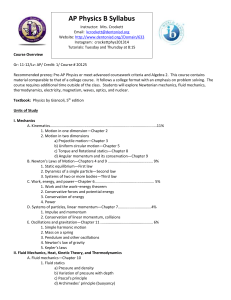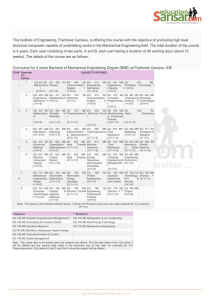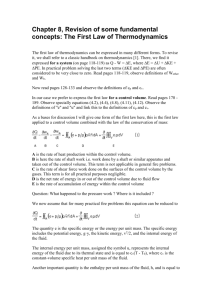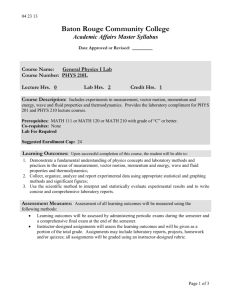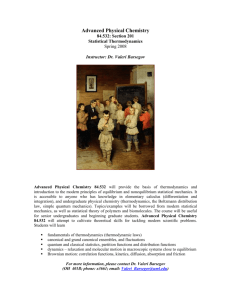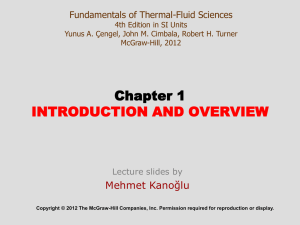Thermal Fluid - Faculty of Engineering and Technology
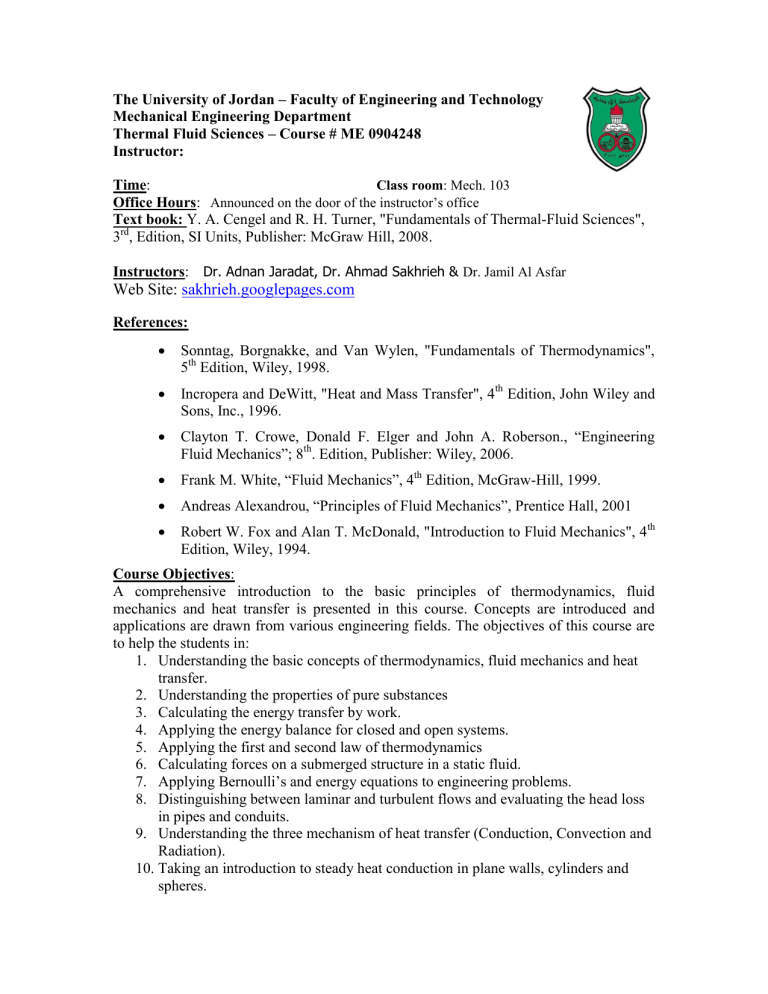
The University of Jordan – Faculty of Engineering and Technology
Mechanical Engineering Department
Thermal Fluid Sciences – Course # ME 0904248
Instructor:
Time : Class room : Mech. 103
Office Hours : Announced on the door of the instructor’s office
Text book: Y. A. Cengel and R. H. Turner, "Fundamentals of Thermal-Fluid Sciences",
3 rd
, Edition, SI Units, Publisher: McGraw Hill, 2008.
Instructors :
Dr. Adnan Jaradat, Dr. Ahmad Sakhrieh &
Dr. Jamil Al Asfar
Web Site: sakhrieh.googlepages.com
References:
Sonntag, Borgnakke, and Van Wylen, "Fundamentals of Thermodynamics",
5 th
Edition, Wiley, 1998.
Incropera and DeWitt, "Heat and Mass Transfer", 4 th
Edition, John Wiley and
Sons, Inc., 1996.
Clayton T. Crowe, Donald F. Elger and John A. Roberson., “Engineering
Fluid Mechanics”; 8 th
. Edition, Publisher: Wiley, 2006.
Frank M. White, “Fluid Mechanics”, 4 th
Edition, McGraw-Hill, 1999.
Andreas Alexandrou, “Principles of Fluid Mechanics”, Prentice Hall, 2001
Robert W. Fox and Alan T. McDonald, "Introduction to Fluid Mechanics", 4 th
Edition, Wiley, 1994.
Course Objectives :
A comprehensive introduction to the basic principles of thermodynamics, fluid mechanics and heat transfer is presented in this course. Concepts are introduced and applications are drawn from various engineering fields. The objectives of this course are to help the students in:
1.
Understanding the basic concepts of thermodynamics, fluid mechanics and heat transfer.
2.
Understanding the properties of pure substances
3.
Calculating the energy transfer by work.
4.
Applying the energy balance for closed and open systems.
5.
Applying the first and second law of thermodynamics
6.
Calculating forces on a submerged structure in a static fluid.
7.
Applying Bernoulli’s and energy equations to engineering problems.
8.
Distinguishing between laminar and turbulent flows and evaluating the head loss in pipes and conduits.
9.
Understanding the three mechanism of heat transfer (Conduction, Convection and
Radiation).
10.
Taking an introduction to steady heat conduction in plane walls, cylinders and spheres.
Required Background or Experience:
1.
Differentiation and integration.
2.
Simple vector operations.
3.
Concepts of velocity, acceleration, force and energy.
4.
Newton’s laws of motion.
5.
Center of gravity and the moment of inertia
Course Contents:
The following topics will be covered in this course:
Topics
Chapter 1
Introduction and Overview
Classes
3 Classes
THERMODYNAMICS
Chapter 2: Thermodynamics Concepts and Definitions
HW# 1 : 2.35
, 49, 60, 67, 86 & 89
Chapter 3:
Energy Transfer by Heat, Work, and Mass
Chapter 4: Properties of Pure Substances
HW# 2: 4.25, 50, 58, 60-73, 74 & 102
Chapter 5: The First Law of Thermodynamics:
Closed Systems
HW# 3: 5.18, 37, 38, 64, 98 & 99
Chapter 6: The First Law of Thermodynamics:
Open Systems
HW# 4: 6.30, 50, 55, 75 & 83
Chapter 7: The Second Low of Thermodynamics
HW# 5: 7.21
, 49, 52, 85, 99, 102 & 125
3 Classes
2.34
& 65
6 Classes
6 Classes
4.23
, 47 & 57
6 Classes
5.9
, 40, 43, 108 &117
3 Classes
6.60
, 80, 86, 91 & 107
3 Classes
7.105
, 121 & 127
HEAT TRANSFER
Chapter 16: Mechanism of Heat Transfer
HW# 6: 16.25
, 30, 41, 67 & 69
Chapter 17: Steady Heat Conduction
HW# 7: 17.17, 20, 26 & 57
FLUID MECHANICS
Chapter 9: Introduction to Fluid Mechanics
3 Classes
16.42
, 59 & 61
3 Classes
17.19
& 52
3 Classes
Chapter 10: Fluid Statics
HW# 8: 10.13
, 18, 20, 22, 31, 37, 39 & 41
Chapter 12: Bernoulli and Energy Equations
HW# 9: 12.30, 36, 39, 43, 61 & 63
Chapter 14: Flow in Pipes
HW# 10: 14.31, 40, 59, 73, 77, 84, 88 & 93
3 Classes
10.15
& 17
3 Classes
12.55
& 57
3 Classes
14.47
& 78
Tables A.1 – A.27
(pp 988-1030)
Expected Outcomes:
Students will be expected to develop the following skills/understanding upon the successful completion of Thermal-Fluid Sciences course:
1.
Ability to solve manometer problems
2.
Ability to use property tables and using the ideal gas equation of the state
3.
Ability to calculate the energy transfer by heat and workgroup
4.
Ability to apply the first and second laws of thermodynamics for different engineering applications.
5.
Ability to calculate forces on submerged and floating bodies.
6.
Ability to use conservation of mass principle to calculate flow rates through control volumes.
7.
Ability to use Bernoulli’s equations and ability to apply conservation laws for mass, momentum and mechanical energy.
8.
Ability to solve hydraulic pipe flow problems using Moody’s diagram for skin friction to calculate flow rate, pressure loss and pipe diameter.
9.
Ability to calculate heat transfer by conduction, convection and radiation.
10.
An ability to seek and learn new materials outside the class topics.
Remarks:
I. Attendance:
Attendance of classes is obligatory. Students are expected to attend EVERY CLASS
SESSION and they are responsible for all material, announcements, schedule changes, etc., discussed in class. Absence must be verified according to the university’s regulation.
II. Homework Assignments:
The homework must represent an individual work of a student. All homework problems should be submitted on the due date. The Assignments should be collected at the beginning of the class on the due date. Late homework will NOT be accepted (i.e., it will be awarded a zero). Please write only on one side of the page. Your name and ID number should be clearly written on first page. Start each problem on a new page. Clearly mark your answers in a box (Never use a red pen in your work). Staple the pages together.
Discuss the assignments among yourselves. This is helpful to the learning process.
Copying any text or graphics from another person’s homework or manual solution may be viewed as an attempt of plagiarism, and will be heavily penalized.
Note : All cases of academic dishonesty will be handled in accordance with university policies and regulations.
III. Quizzes:
There will be a number of announced quizzes during the semester. Students are expected to be ready to take a quiz any time they have a class. There will be no make-up quizzes.
Grading:
There will be on the basis of demonstrated knowledge, based roughly 30% on the midterm exam, 5% on the homework, recitation, 15% on the quizzes and 50% on the final exam.
Homework & Assignments:
Quizzes and participation:
Midterm Exam:
Final exam:
5%
15%
30%
50%
(Due on time)
